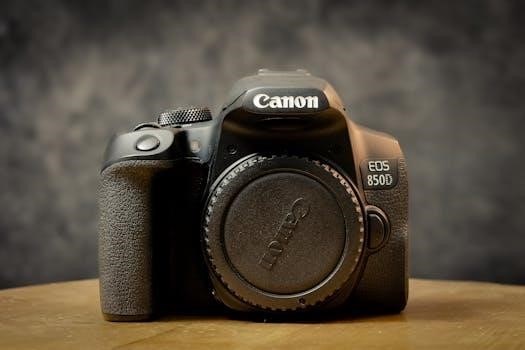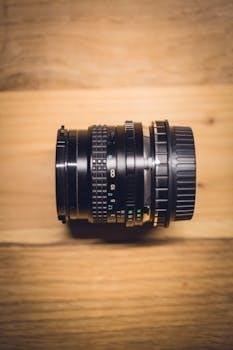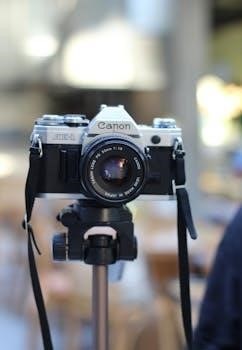The Canon AE-1 Program is a popular 35mm film SLR camera, and its user manual is essential for understanding its features. This manual provides guidance on operation, from basic settings to advanced techniques. Many users seek digital versions of the manual.
Overview of the Canon AE-1 Program
Released in 1981, the Canon AE-1 Program succeeded the AE-1, offering enhanced features, including a program auto-exposure mode. It’s a popular choice among film photography enthusiasts due to its balance of automatic functions and manual controls. The camera uses Canon FD lenses and has a robust build. Its user manual is crucial for both beginners and experienced photographers. The manual covers aspects such as loading film, setting exposure, and using different shooting modes. It is available in multiple languages, both online and in print.
Key Features of the AE-1 Program
The AE-1 Program boasts several key features detailed in its user manual. These include automatic and manual exposure modes, making it versatile for various photographic situations. The manual thoroughly explains these functionalities.
Automatic Exposure Modes⁚ Program AE
The Program AE mode, as explained in the Canon AE-1 Program user manual, allows for fully automatic exposure. When using Program AE, the camera automatically selects both the aperture and shutter speed. This simplifies the shooting process, particularly for beginners. However, the manual also clarifies that Program AE is only fully functional with Canon FD lenses. The manual details how to ensure the lens is set correctly for this mode, typically to the “A” setting. It also mentions the importance of proper settings to achieve optimal results.
Manual Controls
According to the user manual, the Canon AE-1 Program offers a range of manual controls, allowing users greater creative freedom. The manual explains how to manually adjust both the aperture and shutter speed. This is crucial for photographers who want precise control over depth of field or motion blur. The manual details the location of the dials and how to use them effectively. It also discusses how manual settings can be used to achieve specific photographic effects, and how to combine these controls for optimal image results.
Shutter-Speed Priority AE
The Canon AE-1 Program user manual details the function of Shutter-Speed Priority AE. This mode allows the user to select a desired shutter speed, while the camera automatically adjusts the aperture for proper exposure. The manual guides users on how to set the camera to this mode. According to the manual, this is useful for capturing action shots or controlling motion blur, and it gives the user more control over the movement depiction. The user manual explains how to ensure the correct exposure using this AE mode.

Lens Compatibility
The Canon AE-1 Program primarily uses Canon FD lenses, as outlined in the user manual. The manual also provides guidance on using non-FD lenses with some limitations and specific considerations that are outlined in the manual.
Use of Canon FD Lenses
The Canon AE-1 Program is designed to fully utilize Canon FD lenses, enabling features like programmed auto-exposure. According to the user manual, these lenses are crucial for the camera’s automatic functions. The manual provides specific instructions on how to mount and use FD lenses correctly. Some FD lenses have a green mark, which is important for achieving automatic exposure. The user manual details how this interacts with AE modes and is essential for proper operation. It’s important for users to consult the manual to ensure optimal performance with FD lenses.
Non-FD Lens Usage
While the Canon AE-1 Program is optimized for Canon FD lenses, the user manual addresses the use of non-FD lenses. It specifies that automatic exposure modes are not available with non-FD lenses. The manual usually contains instructions on using such lenses in manual mode, focusing and setting the aperture directly on the lens. Typically users can still take pictures but must take care to set the correct exposure. The manual warns that using non-FD lenses may affect the camera’s automatic functions. Always refer to the manual for complete guidance on non-FD lens operation.
Flash Photography
The Canon AE-1 Program manual covers flash photography, detailing compatible Speedlites. It explains how to synchronize the flash with the shutter for proper exposure, and it offers guidance on automatic flash operation.
Speedlite Compatibility
The Canon AE-1 Program is compatible with a range of Canon Speedlites, offering flexibility in flash photography. The user manual details which specific Speedlite models are fully compatible, ensuring proper function and automatic exposure. It is crucial to consult the manual to understand the capabilities and limitations of each flash unit with the AE-1 Program. The appropriate Speedlite can dramatically improve low light and fill-flash performance. Using non-compatible flashes might not synchronize properly, or could damage the camera. The manual provides important instructions for optimal results when using flash.
Flash Synchronization
Flash synchronization is a critical aspect of using the Canon AE-1 Program with external flash units. The camera synchronizes with flashes at a specific shutter speed, typically 1/60th of a second. The user manual explains this synchronization process, ensuring that the flash fires at the correct moment to properly expose the image; Understanding flash sync is essential to prevent dark bands or uneven lighting in flash photography. The manual also describes how to set the camera for flash use, including the correct shutter speed and aperture settings. It is crucial to follow these settings for correct flash exposure.

Availability of User Manuals
User manuals for the Canon AE-1 Program are widely available online. These manuals can be found in PDF format, often offered for free. Many are also available in multiple languages.
Online PDF Manuals
Numerous websites offer free downloadable PDF versions of the Canon AE-1 Program user manual. These digital manuals provide a convenient way to access detailed instructions on camera operation. Users can easily search for specific functions or troubleshooting tips within the PDF documents. These readily available resources help both new and experienced photographers understand and maximize their camera’s capabilities. This makes learning the camera much more accessible. Various websites and forums also host the manual for free, so users can choose the most suitable one.
Multilingual Manuals
Recognizing the global appeal of the Canon AE-1 Program, user manuals are available in multiple languages. These multilingual manuals cater to a diverse user base, ensuring that photographers worldwide can understand and operate their cameras effectively. Languages such as Spanish, Japanese, and others are often included. This accessibility is particularly helpful for those who do not speak English. The translations allow users to comfortably learn the camera’s features in their native language. These manuals are vital for clear and comprehensive understanding.

Troubleshooting and Maintenance
The Canon AE-1 Program, like any mechanical device, can experience issues. The user manual offers valuable troubleshooting tips and maintenance guidance to ensure optimal performance. Addressing these issues helps extend the camera’s lifespan.
Common Issues and Solutions
Users of the Canon AE-1 Program may encounter several common issues. These can include problems with the shutter mechanism, the light meter not functioning correctly, or issues related to film loading and advancement. The user manual provides solutions for these, such as cleaning the battery contacts, checking the lens connection, and ensuring the film is correctly loaded. Additionally, specific issues can be addressed by checking the exposure mode settings and examining the lens aperture ring. Often, a thorough reading of the manual can resolve many problems.
Basic Camera Checks
Before using the Canon AE-1 Program, performing basic checks is crucial. The user manual outlines these steps, including ensuring the battery is fresh and correctly installed. Verify that the shutter operates smoothly at various speeds, and that the film advance lever functions without resistance. Check the lens mount and the lens itself for cleanliness and proper attachment. Confirm the light meter is responding by viewing changes in the viewfinder. These basic checks, detailed in the manual, ensure the camera is ready for use.

Additional Resources
Beyond the user manual, many online resources exist for the Canon AE-1 Program. These include video tutorials and active user forums, offering further assistance and community support for photographers.
Tutorial Walkthroughs
Numerous online tutorial walkthroughs are available for the Canon AE-1 Program, catering to both beginners and experienced users. These tutorials often provide step-by-step instructions on loading film, using different shooting modes, and understanding the camera’s various functions. Video tutorials can be particularly helpful, demonstrating the practical aspects of operating the camera. Many of these walkthroughs are offered on platforms like YouTube and photography blogs, offering accessible guidance to users seeking visual assistance. They offer a great supplement to the user manual.
User Communities and Forums
Online user communities and forums dedicated to film photography often feature discussions about the Canon AE-1 Program. These platforms offer a space for users to share their experiences, ask questions, and receive advice from other enthusiasts. Forums can be invaluable resources for troubleshooting specific issues or learning about advanced techniques not covered in the user manual. Users can also find tips on film choices, lens recommendations, and maintenance advice within these communities. This peer-to-peer support enhances the overall user experience.